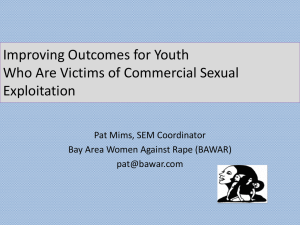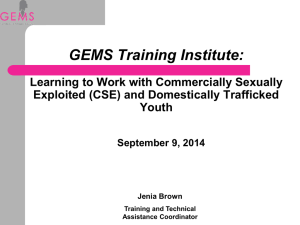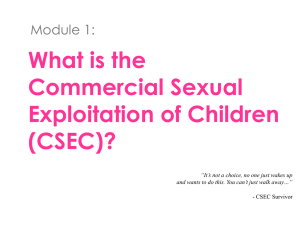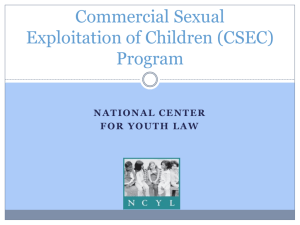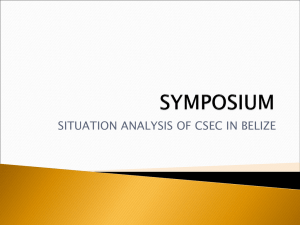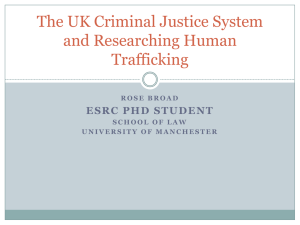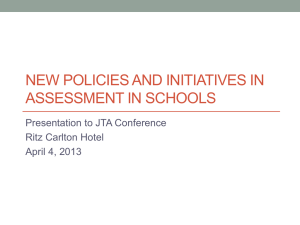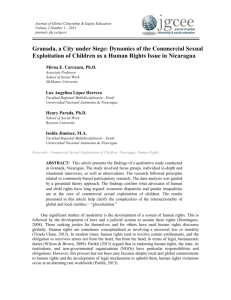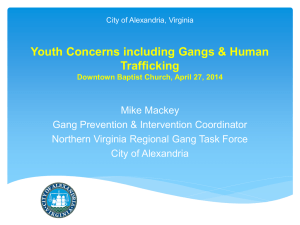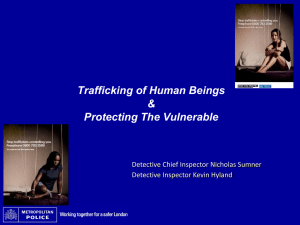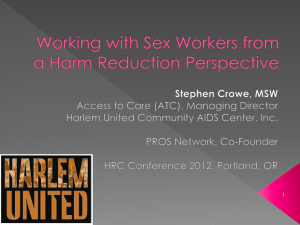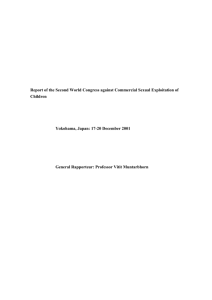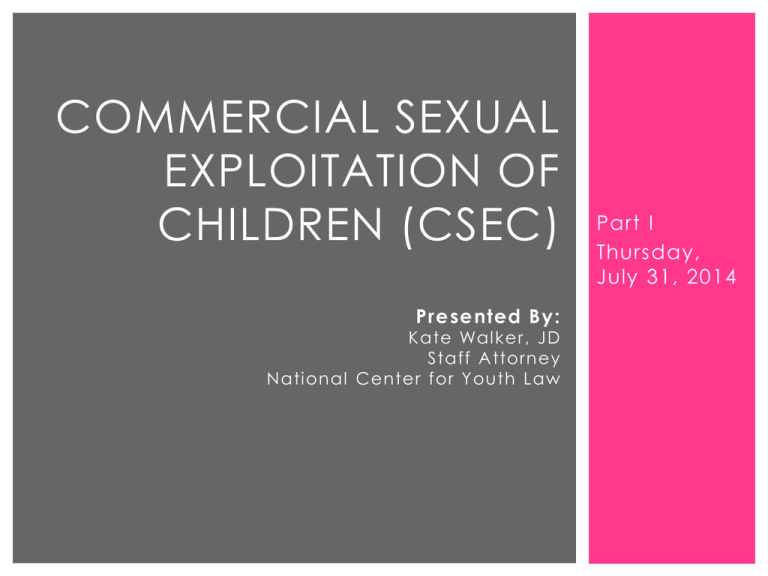
COMMERCIAL SEXUAL
EXPLOITATION OF
CHILDREN (CSEC)
Presented By:
Kate Wal ker , JD
Staff A ttorney
National Center for Youth Law
Part I
Thursday,
July 31, 2014
CURRENT EFFORTS IN CALIFORNIA
California Child Welfare Council
“Ending CSEC: A Call For Multi-System Collaboration in California”
Goal: Ensure a coordinated, collaborative response to CSEC and
children at risk for such exploitation in California that is trauma informed, prioritizes the survivors’ voice, and accounts for the stages
of change.
• CSEC Action Team: Overarching state body to monitor and
oversee implementation of recommendations
• Key Recommendations:
1) Prevalence & Assessment
2) Prevention & Training
3) Specialized Services
4) Multi-System Data & Coordination
County Effor ts
RECENT LEGISLATIVE ACTION IN CA
Newly created CSEC Program
Counties may elect to participate
Requirements:
Interagency Protocol
Benefits
Allocated a portion of the $14 Million
Clarification to W&IC § 300
300(b)(2) The Legislature finds and declares that a child who is
sexually trafficked, as described in Section 236.1 of the Penal Code ,
OR
who receives food or shelter in exchange for, OR
who is paid to perform, sexual acts described in Section 236.1 or
11165.1 of the Penal Code, AND
whose parent or guardian failed to, or was unable to, protect the
child,
is within the description of this subdivision , and that this finding is
declaratory of existing law. These children shall be known as
commercially sexually exploited children .
KEY COMPONENTS IN AN EFFECTIVE
CSEC SERVING SYSTEM
Screening, and identifying victims
Education and Awareness - all agencies use the same
language
Safety planning for youth, families and the staff serving
them
Collaboration across the multiple child -serving
systems and agencies, including CBOs, FBOs, etc.
Tracking, collecting, and sharing data
Trauma-informed system of care
Appropriate placements trained to serve CSEC
Trust and Relationship building to improve service
provision
Culturally competent and appropriate services
Survivor involvement in designing and implementing
programming for CSEC
THIS PRESENTATION IS BROUGHT TO YOU BY:
The Academy of Professional Excellence
Public Child Welfare Training Academy
Presented by:
Anzette Shackelford, PCWTA County Consultant
PCWTA is a program of the Academy for Professional
Excellence at San Diego State University School of Social
Work in collaboration with our University partners, CSU San
Bernardino,
Loma Linda University and CSU Fullerton
SOUTHERN RTA (PCWTA)
ADDRESSING HUMAN TRAFFICKING
AND THE COMMERCIAL SEXUAL
EXPLOITATION OF CHILDREN (CSEC)
IN SOUTHERN, CA
Part II
Thursday,
July 31, 2014
BUILDING AWARENESS
Partnered with local Human Trafficking Task force
(CASE Program and Operation Safe House ) to:
• Provide Regional Awareness Training to Child
Welfare Staff
• Provide Awareness Training to PCWTA staff
Delivering a webinar for CalSWEC on 10/28/2014
TRAINING MODALITIES
Developing Online Training
Modalities:
Elearning
- Awareness
- Assessment
- Information
Mobile APP
- Assessment tools
- Resources
Statewide Webinar
Webinar 10/28/2014 (CalSWEC)
Goal: To educate and foster a deeper awareness of
human trafficking and CSEC throughout the child
welfare community
• Designed to provide a broad overview of Human
Trafficking
• Based on findings from the literature review, and
ongoing research on the topic of CSEC and
Domestic Minor Sex Trafficking (DMST)
• Focuses on the impacts and implications to the child
welfare system
CALSWEC WEBINAR OBJECTIVES
•Discusses identification, assessment, and promising
intervention strategies
•Review of current federal, state, and local efforts to
address the wide variety of issues associated with trafficking
•Explore risk factors that contribute to the initial recruitment
and ongoing victimization of young people by traffickers
•Identify appropriate and effective responses and national
and local resources
•Provide information about the multi -systems response to
working with victims
RESEARCH
•
Literature Review for SACHS
•
Casey National Research Project (Not yet published
or available to the public)
•
Ongoing Review of:
•
Attend Conferences On Human Trafficking:
(Southern Area Consortium of Human Services )
- Federal/State Adopted and Proposed Legislation
- Budget Committee proposals regarding CSEC
- National Symposium on Child Abuse (NCAC) – March
2014
- ABA Conference on Human Trafficking – March 2013
Things to Come:
Continuing the Work
PCWTA Trainers Forum – CSEC Presentation
Continued participation in Statewide
Action Team Sub Committees
- Prevention and Training
- Prevalence and Assessment
- Specialized Services &Placement
Developing a Regional CSEC Training Plan
including a regional collaborative
Classroom Training - Requests from counties
OUR PARTNERS
Riverside, CA - Anti –Human Trafficking Taskforce:
• Operation SafeHouse: http://operationsafehouse.org/
• Million Kids: MillionKids.org
San Bernardino, CA - Coalition Against Sexual Exploitation (CASE):
San Bernardino County CASE Program
https://www.facebook.com/sanbernardinoCASE
San Diego, CA - PCI and the Bilateral Safely Corridor Coalition (BSCC)
• http://www.bsccoalition.org/
• http://www.pciglobal.org/
Orange County, CA – Community Service Programs (CSP) Human
Trafficking Program: http://www.cspinc.org/Human%20Trafficking
COMMERCIAL SEXUAL
EXPLOITATION OF
CHILDREN (CSEC)
Presented By:
Tenia Dav is, MSW
Curricul um and Ev al uation A nal yst
Cal ifornia Social Work Educati on Center (Cal SWEC)
Univ ersity of California, Berkeley
Part III
Thursday,
July 31, 2014
RISK FACTORS
Individual
[Internal]
• Sexual abuse
• Abuse
• Neglect
• Runaway
• Homelessness
• LGBTQ
• Mental health issues
• Unaddressed trauma
• Developmental/
learning disabilities
Environmental
[Micro/Situational]
• Adult sex industry
• Substance abuse
• Transient male
population
• Poverty
• Violence
• Street-involved
culture/economy
Lloyd, R., & Orman, A. (2010) Training Manual on the Commercial Sexual Exploitation of Children (CSEC) : Module 2
Social
[Macro / Contextual]
• Racism
• Sexism & misogyny
• Homophobia
• Transphobia
• Sexualization of boys
• Acceptance of
violence against
women and minority
groups
• Glorification of pimp
culture
• Materialism and
consumerism
• Inaccessibility of
legal economies
• Access to
technology
WHO IS AT RISK FOR RECRUITMENT?
Children who:
Are under 18 years old
Walk to school or to the store alone
Own or have access to a computer
Are attracted to consumer goods
Desire to develop romantic relationships
Sometimes feel insecure
Feel misunderstood
Fight with their parents
Sometimes feel their parents don’t care
Want more independence
Test boundaries and take risks
Question:
According to this, who is at risk for recruitment into CSEC?
All Children
Lloyd, R., & Orman, A. (2010) Training Manual on the Commercial Sexual Exploitation of Children (CSEC) : Module 2
ESSENTIALS OF SERVICE DELIVERY
F OR Y O UT H E X I TI NG ‘ T H E L I F E ’
Safe Space
Physical safety
Safe Space
Choose a safe location
Set rules for appropriate conduct for youth
Emotional safety
Decorate the space with appropriate, informational,
and/or inspiring images
Respect children’s need for privacy and confidentiality
Cultural Competency
Make sure that staff have a thorough understanding of
impact, dynamics, and subcultures of CSEC
Support survivor voices and/or work with survivors of
CSEC
Cultural
Competency
Youth Development
Believe that all sexually exploited children have the
ability to be leaders
Foster a sense of belonging and importance in the
community
Lloyd, R., & Orman, A. (2010) Training Manual on the Commercial Sexual Exploitation of Children (CSEC) : Module 4
Youth
Development
STAGES OF CHANGE
As youth make strides to exit ‘the
life’ their progress commonly
follows the Stages of Change
model:
Pre-contemplation
Not yet acknowledged that there is
a problem behavior
Contemplation
Acknowledging a problem but not
yet ready or sure of wanting to
make a change
Preparation
Getting ready to change
Action
Changing behavior
Maintenance
Maintaining a behavior change
Relapse
Returning to old behaviors and
abandoning the new changes
Lloyd, R., & Orman, A. (2010) Training Manual on the Commercial Sexual Exploitation of Children (CSEC) : Module 4
Graphic: The Australian Government Department of Health:
Module 9: Working with Youth People on AOD Issues: Learner’s
Workbook
ADDITIONAL RESOURCES
Training Manual on the Commercial
Sexual Exploitation of Children
(CSEC)
Presented by Kristi House / Project
GOLD
Developed by CSEC Community
Intervention Project (CCIP)
Written by Rachel Lloyd and Amallia
Orman
http://www.kristihouse.org/csec ccip-training-materials/
Renting Lacy: A Story of America’s
Prostituted Children (A Call to
Action) by Linda Smith and Cindy
Col oma
Girls Like US: Fighting for a World
Where Girls Are Not for Sale: A
Memoir by Rachel Ll oyd
The White Umbrella: Walking with
Survivors of Sex Trafficking
by M ary Frances Bowley and Louie
Giglio
Human trafficking:
Rachel Lloyd at
TEDxUChicago 2012
CONTACT INFORMATION
Kate Walker, Attorney, National Center For Youth Law
510.835.8098 x 3050
kwalker@youthlaw.org
Anzette Shackleford, PCWTA County Consultant, Academy
for Professional Excellence, SDSU School of Social Welfare
619.564.9253
ashackelford@mail.sdsu.edu
Tenia Davis, Curriculum and Evaluation Analyst,
CalSWEC, UC Berkeley School of Social Welfare
510.643.9845
teniad@berkeley.edu

